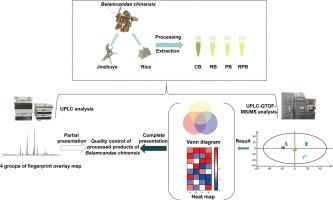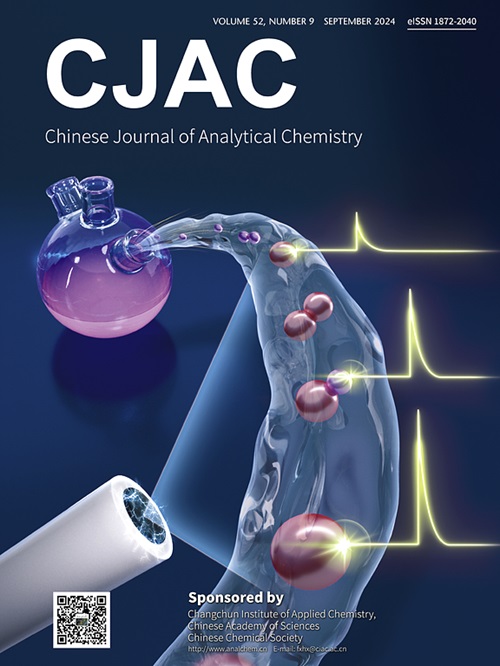中国Belamcanda ensis的化学特征变化:粗制和加工样品的代谢组学分析
IF 1.3
4区 化学
Q4 CHEMISTRY, ANALYTICAL
引用次数: 0
摘要
Belamcanda chinensis (BC)是一种具有悠久使用历史的传统中草药。然而,很少有研究调查未加工和加工的BC之间化学成分的变化。本研究旨在鉴定BC加工后存在的差异化合物,为优化其加工工艺和质量控制提供科学依据。本研究根据相关文献和历史文献,制备了三种加工产品:米加工水提物(RB)、竹竹叶(Phyllostachys bambusoides Sieb)。大米水提物与竹叶竹叶的复配。等zucc加工(RPB)。在Agilent 1290液相色谱上进行超高效液相色谱(UPLC)指纹图谱分析,评价不同BC样品中10种主要黄酮类化合物的相似性。此外,利用超高效液相色谱-四极杆飞行时间质谱(UPLC-QTOF-MS)的非靶向代谢组学方法来鉴定差异代谢物。指纹图谱分析显示,未加工和加工样品中10种主要黄酮类化合物含量无显著差异。非靶向代谢组学鉴定出85种差异代谢物,在RB、PB和RPB处理组中分别检测到57、60和63种代谢物。与生BC相比,RB组16种代谢物水平升高,41种代谢物水平降低;PB组代谢产物上调11种,下调49种;而RPB组显示15种代谢物升高,48种代谢物降低。在这些加工组中,与RB相比,PB和RPB表现出更相似的代谢谱。这些发现代表了对加工BC的化学成分的首次系统调查,从而解决了现有研究中的一个关键空白。此外,它们为优化加工技术和加强质量控制奠定了科学基础,同时也有助于传统加工理论的现代化和重新解释。本文章由计算机程序翻译,如有差异,请以英文原文为准。

Chemical profiles changes in Belamcanda chinensis: A metabolomic analysis of crude and processed samples
Belamcanda chinensis (BC) is a traditional Chinese herbal medicine with a long history of use. However, there are few studies investigating the variations in chemical composition between unprocessed and processed BC. This study aimed to identify the differential compounds present after the processing of BC and to establish a scientific basis for optimizing its processing technology and quality control. In this study, three types of processed BC products were prepared based on relevant literature and historical texts: water extract of rice-processed (RB), leaves of Phyllostachys bambusoides Sieb. et Zucc-processed (PB), and a combination of water extract of rice with leaves of Phyllostachys bambusoides Sieb. et Zucc-processed (RPB). Ultra performance liquid chromatography (UPLC) fingerprint analysis was performed on an Agilent 1290 liquid chromatograph to evaluate the similarity of the 10 principal flavonoids among different BC samples. Additionally, an untargeted metabolomics approach using ultra-high performance liquid chromatography-quadrupole time-of-flight mass spectrometry (UPLC-QTOF-MS) was utilized to identify differential metabolites. Fingerprint analysis showed no significant differences in the 10 main flavonoids between unprocessed and processed samples. Untargeted metabolomics identified 85 differential metabolites, with 57, 60, and 63 metabolites detected in the RB, PB, and RPB processed groups, respectively. Compared with raw BC, the RB group showed increased levels of 16 metabolites and decreased levels of 41; the PB group exhibited 11 upregulated and 49 downregulated metabolites; while the RPB group demonstrated 15 elevated and 48 reduced metabolites. Among these processed groups, PB and RPB exhibited more similar metabolic profiles compared to RB. These findings represent the first systematic investigation into the chemical composition of processed BC, thereby addressing a critical gap in the existing research. Furthermore, they establish a scientific foundation for optimizing processing techniques and enhancing quality control, while also contributing to the modernization and reinterpretation of traditional processing theories.
求助全文
通过发布文献求助,成功后即可免费获取论文全文。
去求助
来源期刊
CiteScore
3.60
自引率
25.00%
发文量
17223
审稿时长
35 days
期刊介绍:
Chinese Journal of Analytical Chemistry(CJAC) is an academic journal of analytical chemistry established in 1972 and sponsored by the Chinese Chemical Society and Changchun Institute of Applied Chemistry, Chinese Academy of Sciences. Its objectives are to report the original scientific research achievements and review the recent development of analytical chemistry in all areas. The journal sets up 5 columns including Research Papers, Research Notes, Experimental Technique and Instrument, Review and Progress and Summary Accounts. The journal published monthly in Chinese language. A detailed abstract, keywords and the titles of figures and tables are provided in English, except column of Summary Accounts. Prof. Wang Erkang, an outstanding analytical chemist, academician of Chinese Academy of Sciences & Third World Academy of Sciences, holds the post of the Editor-in-chief.

 求助内容:
求助内容: 应助结果提醒方式:
应助结果提醒方式:


